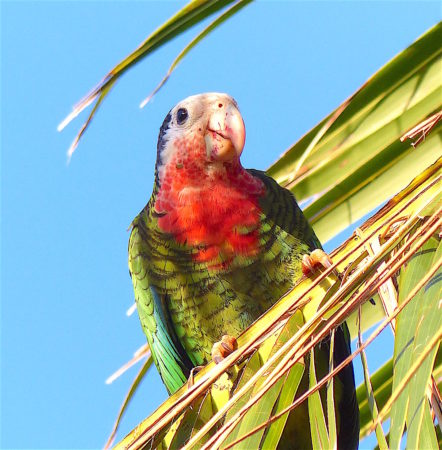
Scott Johnson shares with us his recent experience conducting surveys of Bahama Parrots in the wilds of Great Abaco with Dr. Frank Rivera-Milan— read on to find out more about the challenges these birds face and the results of their work.
The chilly 52 degree breeze stung my face as I headed to our champagne coloured SUV. As the vehicle started and warmed up, I waited patiently for Frank to leave our residence and jump into the jeep. We were staying at the Research Center of Friends of the Environment, a non-governmental organization in Marsh Harbour on the island of Great Abaco, The Bahamas. Once Frank got settled in the vehicle, we began our hour-long drive south to the home of the Bahama Parrots.
The Bahamas National Trust (BNT) is a non-governmental organization that manages the national park system of The Bahamas. It currently protects over 2 million acres of marine and terrestrial ecosystems in its 32 national parks across the Bahamian Archipelago. Great Abaco is the second largest island in The Bahamas, with no less than six national parks. Abaco National Park is the southernmost, consisting of a 22,500 acre terrestrial park and including the habitat of the second largest population of Bahama Parrots.
The Bahama Parrot, which is currently listed as a sub-species of the Cuban Parrot, has three populations on three islands in The Bahamas: Great Abaco, Great Inagua and New Providence. Population monitoring and assessments are important for the management and conservation of these charismatic birds.
Irma’s Impact
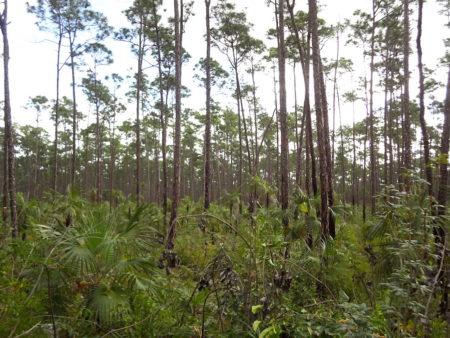
In the destructive fall of 2017, Hurricane Irma passed over the southern Bahamas. devastating the Ragged Island chain. Irma also severely impacted the island of Great Inagua, home of the largest population of Bahama Parrots. After Irma had passed, there was great concern for both the parrot and the American Flamingo populations. How were they doing, and how had they been affected? The BNT decided to conduct post-hurricane assessments. Based on information from BNT park wardens on Great Inagua, most of the flamingos flew to other islands prior to the storm. The status of the parrots remained unknown. Because of logistical challenges, the BNT had to postpone the Bahama Parrot surveys on Great Inagua to late summer. They were anxious, however, to determine the status of the Great Abaco parrots, last surveyed in 2016. The BNT enlisted the help of population ecologist Frank Rivera-Milán, who helped me with the search for these lively birds. With financial support from Birds Caribbean and BNT, we travelled to Abaco on March 23rdand spent 10 days surveying the parrot population in the central and southern parts of the island.
Parrots Disturbing the Peace
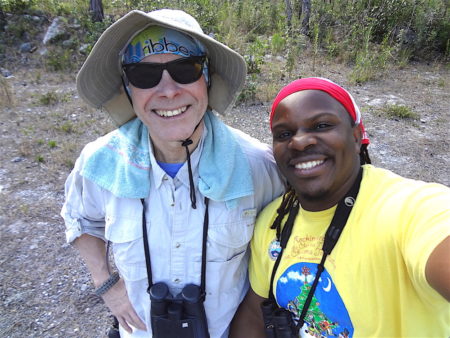
As we approached Abaco National Park, the cool, calm morning was interrupted by the vociferous squawking of dozens of parrots conversing with each other in the pine trees. I was super excited to see them, particularly because I had never seen Bahama Parrots on Abaco, let alone in the pinelands. As my mind began drift away from reality due to the sheer joy of hearing the birds, the survey point was just 200 meters away.
We stopped and parked the car at the point. We quickly got out, binoculars, range finders, and datasheets in hand (and around our necks) and listened and observed attentively. We were conducting point count surveys. Once a parrot was seen or heard, the information (such as the number of birds heard and seen, the distance from the point, food availability and habitat type) was recorded in our datasheet. We counted parrots at each point for 6 minutes.
Parrots – in Holes?
As we were continued counting, a pair of parrots flew into our survey area. “This pair is looking for a nest site,” Frank said. “The female is on the ground inspecting holes and the male keeps watch.” We watched as the female disappeared in the scrubby understory vegetation as the male remained perched on a pine branch just a few feet above her. Bahama Parrots are devoted couples; they tend to mate for life.
There is something very special about the Bahama Parrots on Abaco. They are the only parrots that habitually nest in solution holes underground – that is, holes or crevices created by rainwater dissolving limestone rock. This is an adaptation to the fire-dependent pineland ecosystem. In their holes, the birds can avoid the heat. No other New World parrot engages in such behaviour. Bahama Parrots feed on a variety of plants, such as West Indian Mahogany, Lignum Vitae, Cinnecord, White Torch, Gum-elemi aka Gumbo Limbo, and False-Mastic.
Dangers Lurk
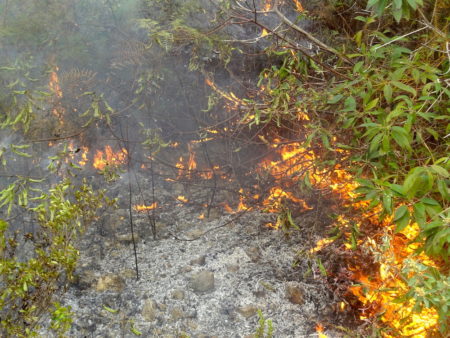
As we were driving to a survey point, we saw some rustling in the vegetation on the side of the road. It was a feral cat. These creatures are the biggest threats to parrots. Hurricanes are seasonal and of course, do not always hit Abaco. Cats present a different kind of danger – an everyday threat. They kill both chicks and incubating females. During the survey, we saw seven cats – three in areas where Bahama Parrots were known to nest. These cats gone wild have been a major conservation problem for the Bahama Parrot on Abaco. However, BNT Park Warden Marcus Davis and colleagues have been making tremendous efforts to remove this invasive species from the park. As a result, the numbers of parrots have increased from an estimated average of about 5,100 in 2008 to about 8,800 in 2016 – an impressive gain of nearly 60% .
Another regular threat is fire. One morning, as we were driving south to our study site, we noticed smoke in the distance, near the area where we had survey points. As we continued driving, the smoke increased and we saw fire in the pinelands and near the road. This fire had just been lit that morning. People often light fires to clear the understory so that they can hunt wild hogs, another invasive animal found in the pinelands.
Although fire plays its part in rejuvenating the pinelands, too many fires can cause great harm to the pine forest ecosystem. Frequent blazes can kill young pine trees and change the composition of the understory vegetation. Often, after pine fires, invasive bracken ferns move into the newly vacant space, blanketing the entire area. These invasive plants can quickly turn a once diverse understory, teeming with fruit-bearing shrubs that the parrots love, into a monoculture of ferns. Bahama Parrots will avoid these fern-dominated areas, which means that there is less suitable breeding and foraging habitat for them. For the Bahama Parrots, this is not good news.
A Healthy Population
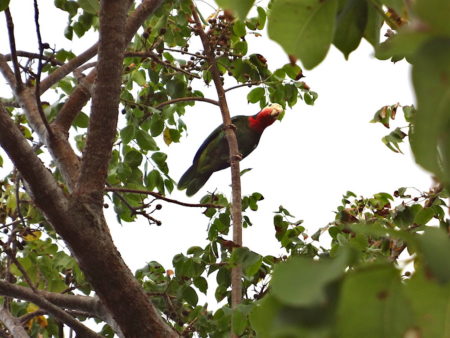
One evening, as we were driving along an old logging road in the pinelands, a flock of parrots flew into view and settled in the canopy of pine trees. Being the “somewhat” impulsive person that I am, I quickly jumped out of the vehicle and ran to the location where I saw the parrots. There they were, dozens of them squawking, their green plumage blending perfectly with the green vegetation, their white faces betraying their presence. The parrots then flew off in unison and headed to what appeared to be their roosting site. As I was observing and thoroughly enjoying the sight of these spectacular birds flying by in a huge flock, the ever-astute Frank was diligently counting. Ninety-three parrots!
After eight days of surveys, we analysed the data, using the program DISTANCE and other statistical software. Based on the survey data collected, we estimated that approximately 8,832 parrots dwell in central and southern Abaco. This suggests that the population appears to be stable and doing well – thanks to the management efforts of BNT’s park wardens. I take my hat off to them!
Conservation Partnerships Are Key
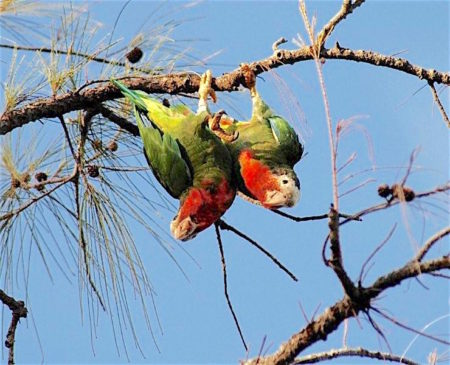
The Bahamas National Trust, BirdsCaribbean and the United States Fish and Wildlife Service continue their partnership to accomplish the mission of managing and conserving wildlife and ecosystems in The Bahamian Archipelago and the Caribbean region. The Caribbean is home to a variety of important species, from endangered Rock Iguanas to American Flamingos. Wildlife management and conservation can be very challenging. It is not just about the animals and birds. It involves people, policy and laws, and the search for the right balance between the needs of humans and the needs of wildlife. As wildlife conservationists, we understand that our work illustrates the importance of biodiversity. We recognize that weare the active voices speaking up for the native and endemic plants and animals that may go extinct if no conservation action is taken.
It is always a joy to see our beautiful parrots flying wild and free. Let’s continue to work together to ensure that our future includes the amazing creatures that also call the Caribbean…home.
By Scott Johnson (Bahamas National Trust) and Frank F. Rivera-Milán (United States Fish and Wildlife Service). Scott is a Science Officer with the BNT; his work focuses on terrestrial fauna in the national parks and he loves Bahamian birds and reptiles. Frank is a Population Ecologist with US Fish and Wildlife Service. He frequently conducts field studies of doves and pigeons. He especially enjoys studying parrots.
Click on the photos below to see a larger version and slide show.








I had the pleasure around 1987 to visit Abaco and see this beautiful Amazona sp. to see what is was eating as part of my Masters in Parrot Nutrition at University of Guelph. Many bitter items compare what people feed to other captive Amazon sp. At that time it was thought there were around 800 to 1,200 on Abaco. So this population has done well – Thanks to efforts by BNT – to educate people and reduce feral cats. I proud to be a Lifetime member of BNT. Hope to meet you one day Scott.
Thanks for sharing your experience with the Bahama Parrot in Abaco many years ago Mark!!! Yes, the BNT does great work – they are wonderful partners of ours. I have had the good fortune to work with them for years as I did my PhD field research on the White-cheeked Pintail in the Bahamas many years ago! All the best, Lisa Sorenson, Executive Director, BirdsCaribbean